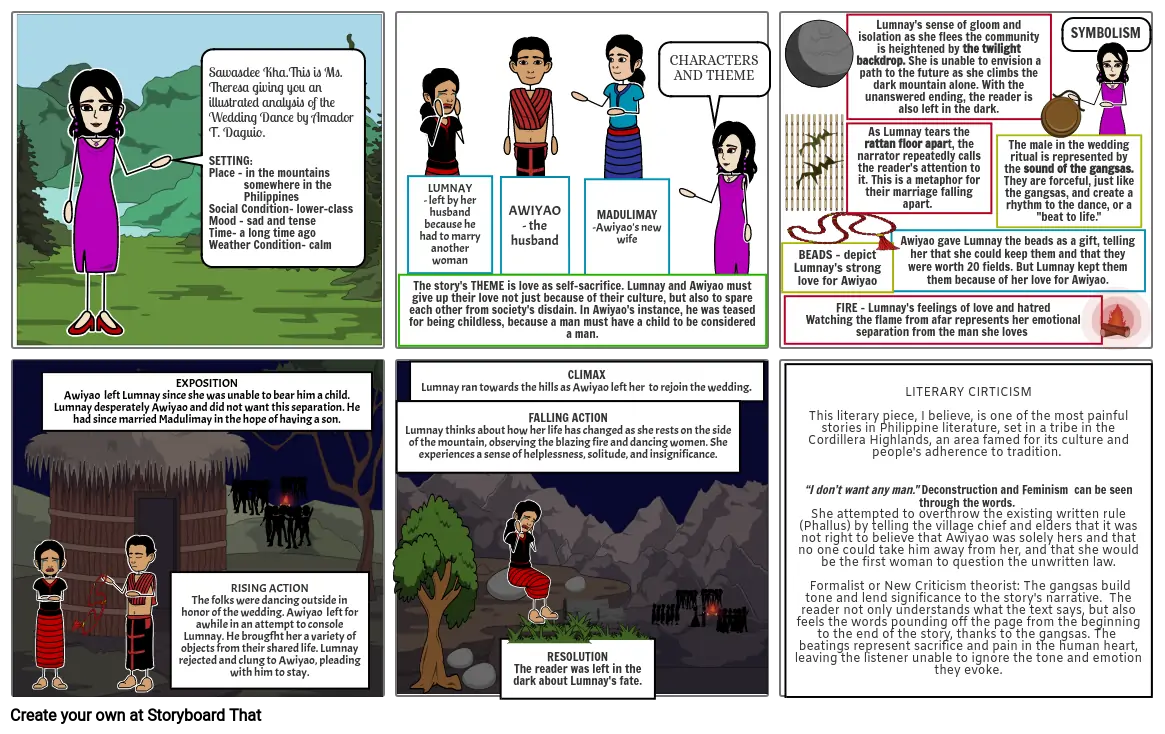THE WEDDING DANCE

Storyboard Text
- Sawasdee Kha.This is Ms. Theresa giving you an illustrated analysis of the Wedding Dance by Amador T. Daguio.SETTING: Place – in the mountains somewhere in the PhilippinesSocial Condition- lower-class Mood - sad and tenseTime- a long time ago Weather Condition- calm
- The story's THEME is love as self-sacrifice. Lumnay and Awiyao must give up their love not just because of their culture, but also to spare each other from society's disdain. In Awiyao's instance, he was teased for being childless, because a man must have a child to be considered a man.
- LUMNAY - left by her husband because he had to marry another woman
- AWIYAO - the husband
- MADULIMAY -Awiyao's new wife
- CHARACTERS AND THEME
- BEADS - depict Lumnay's strong love for Awiyao
- FIRE - Lumnay's feelings of love and hatredWatching the flame from afar represents her emotional separation from the man she loves
- As Lumnay tears the rattan floor apart, the narrator repeatedly calls the reader's attention to it. This is a metaphor for their marriage falling apart.
- Lumnay's sense of gloom and isolation as she flees the community is heightened by the twilight backdrop. She is unable to envision a path to the future as she climbs the dark mountain alone. With the unanswered ending, the reader is also left in the dark.
- Awiyao gave Lumnay the beads as a gift, telling her that she could keep them and that they were worth 20 fields. But Lumnay kept them them because of her love for Awiyao.
- The male in the wedding ritual is represented by the sound of the gangsas. They are forceful, just like the gangsas, and create a rhythm to the dance, or a "beat to life."
- SYMBOLISM
- EXPOSITIONAwiyao left Lumnay since she was unable to bear him a child. Lumnay desperately Awiyao and did not want this separation. He had since married Madulimay in the hope of having a son.
- RISING ACTIONThe folks were dancing outside in honor of the wedding. Awiyao left for awhile in an attempt to console Lumnay. He brougfht her a variety of objects from their shared life. Lumnay rejected and clung to Awiyao, pleading with him to stay.
- FALLING ACTIONLumnay thinks about how her life has changed as she rests on the side of the mountain, observing the blazing fire and dancing women. She experiences a sense of helplessness, solitude, and insignificance.
- CLIMAXLumnay ran towards the hills as Awiyao left her to rejoin the wedding.
- RESOLUTIONThe reader was left in the dark about Lumnay's fate.
- LITERARY CIRTICISMThis literary piece, I believe, is one of the most painful stories in Philippine literature, set in a tribe in the Cordillera Highlands, an area famed for its culture and people's adherence to tradition. “I don’t want any man." Deconstruction and Feminism can be seen through the words. She attempted to overthrow the existing written rule (Phallus) by telling the village chief and elders that it was not right to believe that Awiyao was solely hers and that no one could take him away from her, and that she would be the first woman to question the unwritten law. Formalist or New Criticism theorist: The gangsas build tone and lend significance to the story's narrative. The reader not only understands what the text says, but also feels the words pounding off the page from the beginning to the end of the story, thanks to the gangsas. The beatings represent sacrifice and pain in the human heart, leaving the listener unable to ignore the tone and emotion they evoke.
Over 30 Million Storyboards Created

